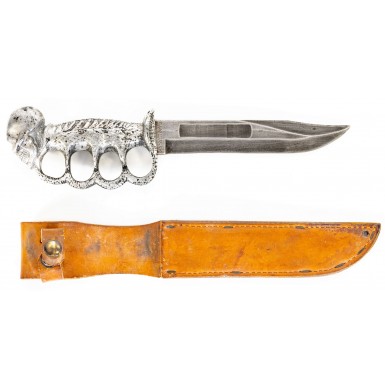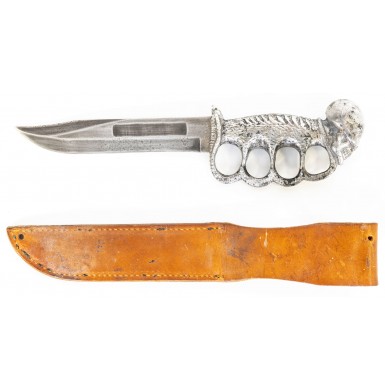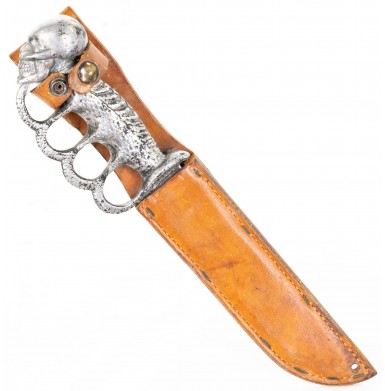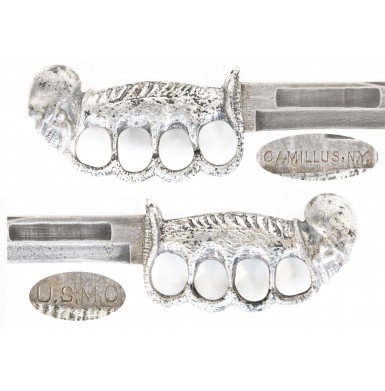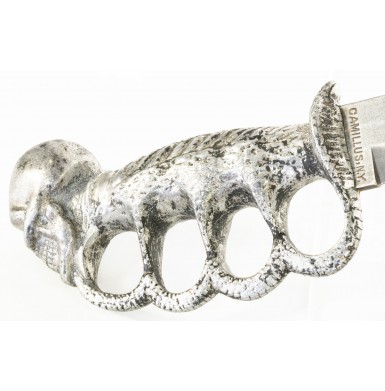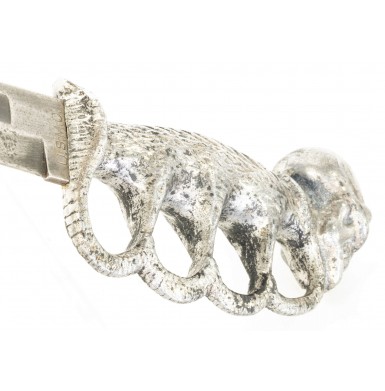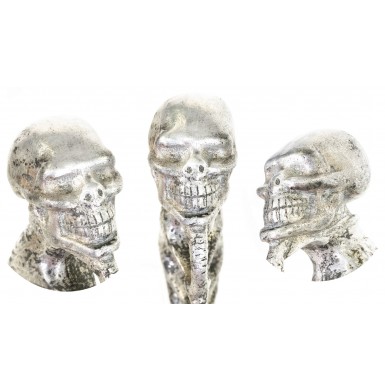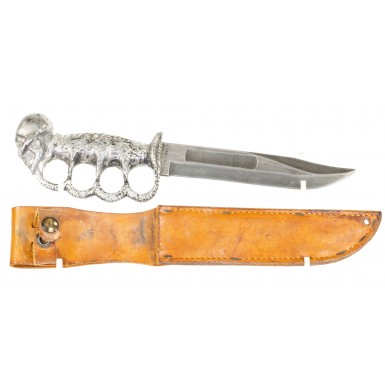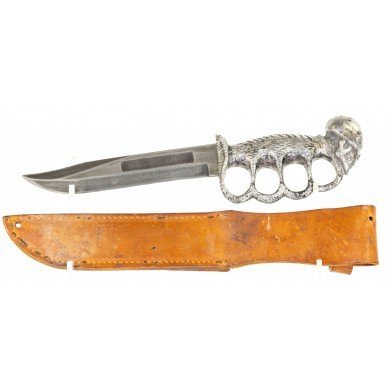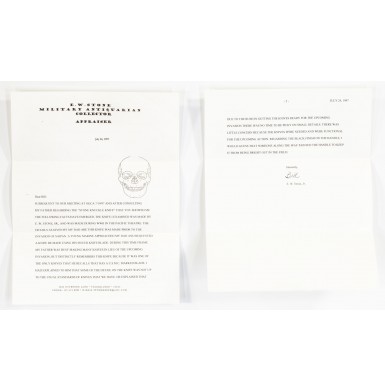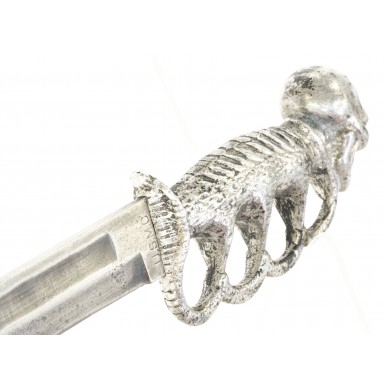Extremely Rare EW Stone Sr "Pig Nose Skull & Cobra" Fighting Knife with Letter of Authentication
- Product Code: EWSK-GB120-SOLD
- Availability: Out Of Stock
-
$8,500.00
At the beginning of World War II, the United States military did not have an issue fighting and utility knife. The only combat knives in storage for potential issue on 7 December 1941 were some of the brass-knuckle US Model 1918 Mark I fighting knives that had been ordered for use in the trenches of World War I, but were delivered too late to see issue or use. Many of those 1918 MkI knives were actually sold off as surplus in the decades between the wars. The military realized that the standard issue Model 1905 bayonet with its 16” blade was not an option for use as a fighting and utility knife and undertook a concerted effort to design, contract for and issue fighting knives to the men heading off to war. While these projects would result in such classic knives as the US Navy’s Mark 1 and Mark 2 knives, the Marine Corps’ 1219C2 knife (better known simply as the KaBar) and the classic M3 Trench Knife, it would be nearly a year before any of those knives would be available for delivery and issue to the men. In the meantime, the soldiers heading off to war acquired factory made hunting knives from such well-known American knife makers as the Union Cutlery Company, the Pal Blade Company, EGW and many others. Smaller American knife makers, craftsmen and machinists also sprang into action. Today names that are famous in the world of combat and custom knife makers like Walter “Bo” Randall, MH “Howard” Cole, John Ek, Frank Richtig, Floyd Nichols, and others would become some of the most renowned knife makers in the world due to the knives that they produced for American soldiers. Companies like San Antonio Iron Works, Knife Crafters and numerous other small shops converted and altered old sword and bayonet blades to create fighting knives as well, and with such alterations the modern concept of the “Theater Knife” was born.
As the American military mobilized and went off to war, the making of real Theater Knives, produced in theater, began with abandon. Most of these newly minted ersatz knife makers were US Navy machinists with access to a well-stocked machine shop and US Navy Sea-Bees who were similarly skilled and again had access to the necessary machinery. It was these makers who took the concept of using reclaimed and recycled materials in the construction of the knives to its pinnacle. Materials such Plexiglas from downed aircraft canopies, various types of plastics from insulation materials, scrap brass and scrap aluminum all found their ways into the knives that were being made, the hilts in particular. Some aircraft parts like Japanese propellers, struts and landing gear were particularly prized by the knife makers as this proprietary aluminum alloy was particularly strong, light and resilient. While some makers forged their own blades, many relied upon the repurposing of blades that already existed. American and Japanese bayonets were often used as blade stock, and issue knives like the Marine Corps “Ka-Bar” or the USN Mk2 were regularly customized and modified by these knife makers.
One of the most famous of these US Navy molder turned knife maker was Machinists Mate Eugene W. “Bill” Stone Sr, who served aboard the USS Holland. The Holland (AS-3) was a submarine tender that was launched in 1926 and saw service through WWII in the Pacific Theater and remained in service until being decommissioned in 1952. During the war Holland refitted submarines fifty-five times, performed repairs on surface vessels twenty times and also did repair and building work for some surface installations. Holland was in Manila Bay in the Philippines when the Japanese attacked Pearl Harbor and almost immediately headed south to Borneo to escape the Japanese attack on that island chain. She moved to Port Darwin in Australia and for the next year provided support and repair services to submarines and surface ships at that location and also built docks and floats while on that station. In February of 1943 she entered Mare Island Navy Yard off the California coast for a refit and then moved to Pearl Harbor in June of 1943 to continue providing repair and support to Pacific fleet submarines and ships. She moved to Midway Atoll in June of 1944 and then moved to join the task force that would invade the Mariana Islands and support their submarines. This included the invasions of Saipan, Tinian, and Guam. In November of 1944 the Holland returned to Pearl Harbor where she was refitted to serve as the headquarters for Vice Admiral Charles A Lockwood Jr who was the commander of the US Submarine Forces in the Pacific. The Holland served in that capacity as well as continuing her mission to support and repair US Navy vessels through the end of the war.
Eugene William “Rocky” Stone Sr was born on 12 November 1920 in Springfield, OH. He was the son of Stephen Stone and Dedo E Borregaard. According to the 1920 Census, his parents were both emigrants with his father having been born in Austria and his mother in Bohemia. His father born circa 1886 and emigrated in 1895. He was employed as a tailor according to the census report. Both parents were able to read and write English and they rented a home on South Greenmount Ave in Springfield, OH. By the 1930 Census Steven had been divorced from Dedo and was listed as a “roomer” in Columbus, OH in the home of Mary E Fritz, who was also an Austrian emigrant. By 1930 Steven was listed as being the father of seven children with Eugene being right in the middle at 9 years old and having two older brothers (ages 11 and 13), one older sister (age 15) , as well as two younger sisters (ages 3 and 7) and a younger brother (age 5). There was also a 16-year-old stepbrother in the home, the son of Mary Fritz. Eugene’s father was still working as a tailor, but as the country was entering the Great Depression a family of this size was likely a difficult one to support. The family apparently moved around to some degree during this period and for at least a period of time lived in Toledo, OH where Eugene attended Thomas A DeVilbiss High School. According to his son Eugene W Stone Jr, his father also attended Springfield High School in Springfield, OH. EW Jr. notes in his May 2002 article in Knife Magazine about his father’s work that his dad developed a love for knives of all kinds as a youngster who helped out on the family farm in the 1930s. EW Jr. also noted that his father took a number of shop classes in high school, including foundry, pattern making and machine shop.
Eugene joined the US Navy on 19 June 1940 with “Cincinnati” listed as his home city and was entered into the rolls of the crew of the USS Holland on 27 April 1941 with the service number 279-6715. His initial rating was F3C (Fireman 3rdClass) and over next few months he worked his way up to Fireman 2nd Class and eventually Fireman 1st Class. Learning a trade in the Navy is quite common and soon Stone was made a Molder 2nd Class. It was in this capacity that that certainly honed the necessary skills that would make him famous in the world of military knife collectors. By the end of the war, he had been made a Molder 1st Class and reached the rank of Chief Petty Officer, who was also the Chief Molder and ran the foundry of the Holland. According to EW Stone Sr.’s June 1946 dated Draft Registration Card, he was living in Toledo, OH immediately following the war and was an “unemployed veteran” who was married to Gerogianna Stone. The draft card description lists Stone as 5’ 10 ¼” tall, 151 pounds with a light complexion, brown hair and blue eyes.
EW Jr.’s reminisces of his father in the May 2002 article note that it was while the Holland was on station in the Philippines, Java, Sumatra and eventually Australia that he had the opportunity to see and handle the numerous styles of ethnographic and indigenous knives in use in the Pacific. It was at this time that he saw the knife that would inspire his iconic “Skull & Cobra” pattern knuckle knife hilt. Using his molding and pattern making skills, Stone worked on his refinement of the design that he would be forever remembered for. After a number of early castings fell short both due to lack of quality alloy and simply not meeting Stone’s own exacting standards, he finally came up with the pattern that would be the basis for the 250 to 300 knives he would produce during World War II. These knives were produced either in the foundry aboard the Holland or in an old foundry in Darwin, Australia. Stone charged $15 per knife and the buyer would also have to provide a knife from which Stone would repurpose the blade. As the pressed leather washers of the USN Mk2 and USMC “Ka-Bar” were not well suited to long term use in the hot and moist environment of the Pacific Theater, the Stone cast aluminum alloy knuckle hilt was a very practical modification. Stone had solved the durability and strength issue with the duraluminum alloy salvaged from the propellers of Japanese aircraft to which he added a little nickel during the smelting process. He also experimented with the chrome molybdenum used in the wing struts of the planes. The earliest knives were primarily produced with blades from USMC or USN issue knives, with the article noting most were Ka-Bar or Pal marked. However, since Pal contract USMC knives were produced in smaller numbers than Camillus contract knives, it seems likely that at least a few of them were used as well.
Production apparently really ramped up with Holland joining the naval task force off the Mariana Islands chain. Marines in particular wanted to obtain his very special “Skull & Cobra” knives and it was noted that during this time the overall casting quality and finishing was of lower quality than most of Stone’s earlier and later knives, as getting them into the field was the highest priority. As the war progressed and the M3 Trench Knife started to appear in the Pacific Theater, Stone started to apply his hilts to those knives, as well as other less common or conventional knives like the V44. The popularity of Stone’s knuckle knife was such that other Navy molders started to produce period theater-made copies of the knives. It appears likely that more knives were produced by his period imitators than by the originator of the design himself. To this day it can be difficult to separate the original Stone-made knives from those who flattered him in the highest way, by copying his work. Letters of authentication from EW “Bill” Stone Jr, particularly from the time when his father was still alive, can be invaluable to the authentication of these knives. Bill knows his father’s work intimately and was also involved with a limited production anniversary issue of the knives. Eugene Stone Sr passed away in Arizona on June 9, 2003, at the age of 82.
Offered here is one of the most desirable variants of the EW Stone Sr. “Skull & Cobra” Knife, the “Pig Nose” variant. These knives have the reputation of having been primarily made for Marines and were typically made out of their issue knives, either the USMC 1219C2 or sometimes USN Mk2 knives. The “pig nose” refers to the shape of the flattened and flared nostrils on the skull and was a period nickname sometimes applied to Marine veterans in the Pacific. The knife is accompanied by a letter of authentication from EW “Bill” Stone Jr. dated 24 July 1997 and from the text it is clear that he discussed this knife with his father after he saw it. According to the letter the knife was made for a Marine prior to the invasion of Saipan in June of 1944. Apparently Stone Sr specifically remembered the knife because it had a USMC marked blade, suggesting that many of his other knives to that point had been made with USN Mk2 blades, as guard marked Marine Corps knives were probably not in the field in significant numbers during that period. The elder Stone noted that the quality and overall finish of the hilts on many of those knives made during that campaign were not quite up to his usual standards, but the priority was making them, not aesthetics. Like the usual Stone hilted knives, the guard is in the form of a cobra’s head with the neck hood spread, the knuckle guard is the snake’s body and the pommel is in the form of a skull. The grip has a scale texture which is not only attractive but also provides a firm grip with wet or slippery hands.
The EW Stone Sr Pig Nosed Skull & Cobra Knife offered here is a wonderful and authentic example. The knife measures 12 1/16” in overall length with a 6 7/8” long blade that is 1 3/16” wide at the widest point. The blade has a single median fuller that 2 5/8” in length. The cast aluminum hilt measures 5 3/8” in length and has Stone’s trademark skull motif pommel, and cobra motif knuckles that terminate in the cobra’s hood around the head forming the guard of the knife with the snake’s mouth forming a slightly forward swept quillon. The skull pommel is nominally 2 ¼” tall and 1 ¼” wide. The blade of the knife is from a Marine Corps 1219C2 Combat Knife (also known as the USMC Mark 2 Combat Knife) that was produced by Camillus. Four contractors delivered Marine Corps combat knives during World War II. The largest number was delivered by the Union Cutlery Company under their brand name KA-BAR, and as a result that became the de facto name for those combat knives, despite the fact that other makers also delivered them. The second largest number or Marine combat knives was delivered by the Camillus company, which was also the contractor who produced the USMC Raider Stiletto. The other two companies who delivered USMC knives were the Pal Blade Company and Robeson, who delivered the smallest number of Marine Corps knives. This example is blade marked CAMILLUS on the obverse ricasso and USMC on the reverse ricasso.
The knife remains in VERY GOOD+ condition, and retains traces of thinned blue on the blade, which gives is a sort of dull smoky patina. The exposed metal has a mostly dull pewter patina that has mixed with the smoky traces of blue. The blade shows some very light sharpening and some freckles of surface oxidation and some minor flecks of very minor surface roughness. The blade is essentially free of any pitting. The aluminum hilt was blacked at some point in time, probably during the period of use and retains some strong traces of that black finish in the recesses and protected areas of the hilt. The aluminum shows some scattered bumps, dings and mars as would be expected of a combat knife that was carried and used. The leather scabbard rates about VERY GOOD to NEAR FINE and is complete and solid. All of the staples and stitching remain intact and in place. The hilt retaining strap and blackened brass snap closure are intact as well. The scabbards shows some scattered light wear and minor staining but is in overall very nice condition and while an original, period and correct pattern scabbard for a USMC combat knife from this period, it is probably a replacement as it is in somewhat better condition than one would expect a leather knife scabbard that was involved in the invasion of Saipan might be expected to be found in.
Overall, this is a really wonderful example of an extremely rare and desirable known maker fighting knife from the World War II period. The EW Stone Jr. letter that accompanies the knife certifies its authenticity and provides a direct point of intersection for this knife and combat in the Pacific Theater, the invasion of Saipan in the summer of 1944. Few WWII Theater Knives have the rarity, desirability and instant recognizability of the “Skull & Cobra” knives of E.W. Stone. This will certainly be the centerpiece of any advanced collection of WWII fighting knives and will be one you will be proud to display for years to come. The knife includes the letter of authenticity from EW “Bill” Stone Jr. dated July 24, 1997, that is shown in the photo section with the knife itself.
SOLD
Tags: Extremely, Rare, EW, Stone, Sr, Pig, Nose, Skull, Cobra, Fighting, Knife, with, Letter, of, Authentication


